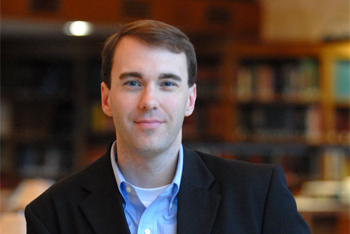Editor’s note: As the Christian landscape changes, leaders must ask and answer a new question: What’s the future of denominations? This interview is part of an occasional series that offers insight on this vital issue. To see the entire series, click here.
 Geoff Moore, a professor of business ethics at Durham University, Durham, U.K., says churches need to create institutional structures that reflect well on their core faith. As a member of the “Receptive Ecumenism and the Local Church” research project in the northeast region of England, Moore works to understand how lessons and practices from one denomination might apply to others in ways that strengthen both. The project began about two and a half years ago.
Geoff Moore, a professor of business ethics at Durham University, Durham, U.K., says churches need to create institutional structures that reflect well on their core faith. As a member of the “Receptive Ecumenism and the Local Church” research project in the northeast region of England, Moore works to understand how lessons and practices from one denomination might apply to others in ways that strengthen both. The project began about two and a half years ago.
Moore is a founding member and former chair (2002-2004) of the UK Association of European Business Ethics Network. He serves on the editorial boards of “Business Ethics Quarterly,” “Journal of Business Ethics” and “Business Ethics: A European Review.”
Q: You’ve been involved with a research project on receptive ecumenism in the local church. What is receptive ecumenism?
The basic idea is that ecumenical relationships tend to be “What have we got that others need to learn from us?” The receptive ecumenist says, “What could we learn from the others?” What could the Catholic Church learn from the Methodist Church and vice versa? What could they both learn from the Anglican Church? If the churches [approach dialogue] from a learning mode rather than a teaching mode, that might affect their practice. As that progresses you might find the churches coming closer together.
Q: How did you become involved in the project?
The Centre for Catholic Studies in Durham got this project going. The idea was for theologians in northeast England to get together and produce a book. Different Christian denominations would state what they were about, in theology and practice and so forth. The idea was that if the denominations begin to compare and contrast, there will be the opportunity for learning.
As part of that project, they had to think about church as an organization. At that point they turned to the business school and said, “Is there anybody up there who might be interested in engaging with us?” And I was certainly one who was interested.
Q: Can you tell us about the particular areas the project is looking at?
The group I’m involved in is looking at governance and finance. The other two are leadership and ministry, and learning and formation.
The leadership and ministry one is looking at the role of ordained ministers -- their leadership styles and how appropriate they are for the different denominations.
The learning and formation one has to do with how both laity and ordained are formed. What training do the ordained ministers go through? How is laity formed in the faith? What’s the process people use for catechism, for ordained education and so forth?
The governance and finance group is looking at the organizational perspective. How do these different churches govern themselves? What’s the structure, and where is the decision-making power? Is it with individual groups? Who looks after what? We’re also looking at what sort of strategies they’re coming up with.
On the finances side of it, we looked at how well-resourced these different churches are. Are they running a surplus or a deficit? What’s the link between the different levels of the church? We look at the financial situation in local congregations, at the intermediate levels and then the regional levels such as dioceses.
Q: What are you finding out?
The churches are struggling with two interrelated issues. Many of these churches are in decline numerically; as a result, many of them are struggling financially. Also, a number of them haven’t got enough people coming forward to be ordained ministers. Even if they had enough people coming forward, they wouldn’t necessarily have enough money to train them, to ordain them and then pay them when they got out there in ministry.
The churches are struggling with decline in different ways. In many cases, local congregations merge. Increasingly you’ve got a minister looking after four, five, six or more rural parishes. That changes what you can expect from the minister. One clear thing coming out of this is that the laity are being encouraged to take on more roles in the church, both practical and spiritual. They’re not only running the Sunday school, they’re also leading worship.
In the Anglican Durham Diocese we now have more readers than we have ordained clergy. They’re lay people who are trained theologically to lead worship. A number of churches are training lay people to take on roles around pastoral care. There’s no longer an expectation that the minister will be the person who does all the visiting within the church. It can be done by a layperson.
Q: Are you hoping that people will look to other traditions for solutions, to ask if they have something that might help?
That’s right. We’re trying to understand what that means at the local level, how the churches are handling it. The minister was somebody who worked alone, as it were, a one-man band. Now, the minister is part of the team. Ministers are not expected to run the show but to be the conductor of the orchestra. Maybe they’ve got a number of parishes to look after and they’re working collaboratively with other ministers and with lay people.
The decline context is very familiar across the different denominations. That forces churches to think strategically. If the income and expenditure are pretty much in balance and you’ve got a minister, then you don’t need to think strategically about the church as an organization. From the work that we’ve done so far, it’s clear that most churches are struggling with what it means to think strategically.
Q: Why is that?
It’s not been a factor in the past, so we’re not used to doing it; we haven’t got ministers who are trained to do it. We don’t want to do strategy, because it feels uncomfortable. Strategy is something that businesses do. It feels like the wrong terminology. We want the church to be church. We don’t want the church to be a business. I can quite understand that.
At the same time, a relatively senior-level person in the diocese said to me, “If we don’t have a strategy, then I don’t know how to deploy the resources.” We’ve got limited resources. We’ve got to make some choices. Can we develop material that might help churches do strategy in ways appropriate for church?
Q: Have you found some denominations or traditions better at thinking strategically than others?
The Salvation Army is very different in this respect. That goes back to its governance structures. It has done strategic plans for a long time.
It’s quite interesting comparing the ways that churches do strategy. For example, in the Catholic Church, strategy resides with the bishop. It’s a very personal thing. In the Roman Catholic diocese in northeast England the last bishop died just over a year ago. Almost immediately there was a huge hiatus because nobody could do anything. You had to wait until the next bishop came in to see what he would choose to do.
For a business organization that would be extraordinary. If the CEO goes, we still have the strategic plan; we know what we’re trying to do. Is this a model that other churches would want to copy? I don’t know. Is that something the Roman Catholic Church needs to learn from other churches, that you could have a strategy that isn’t so personal?
Where strategy is taking place, there seems to be quite a lot of emphasis at what we call the intermediate layer, the circuit in British Methodist terms or the deanery in Anglican or Catholic terms. Quite a lot of churches have been deciding whether they want to reinforce this level or, in the case of the United Reformed Church, actually do away with it.
Methodists are looking at combining circuits to form a bigger circuit. The strategy seems to be driven by financial problems. Will that work? It looks more sensible organizationally, but on the other hand the larger area is less personal.
Over the last year the Anglican Durham Diocese has encouraged all the deaneries to put together a development plan with a strategy for reducing clergy numbers. Might it be worth, for example, having a youth worker who covers the deanery? It asks questions about how the deanery is going to work with other levels, rather than saying, “You’re the local church. You decide.”
Q: You have suggested that Alasdair MacIntyre’s work might offer a helpful framework for looking at churches. Tell us about that.
The particular piece of MacIntyre’s work that I’ve been drawing on is “After Virtue.” MacIntyre argues that when institutions go off in search of success, they squeeze the practice [of virtues] at the core in order to get what equals the external goods, profits and reputation.
Think of the church as an organization that has the practices of faith at its core, worship and so forth. The church ought to prioritize these practices. The institution is there to sustain those practices. Things like budgets and buildings are there in order to help the practices be excellent. That says something about ecclesiology. It says something about what the church offers to the world.
Q: You wrote in a paper for the receptive ecumenism project that “the practice of faith is inevitably and deeply institutionalized …; the question is whether the institution promotes the excellence of the practice of faith or tends to corrupt it.” What do you mean?
People outside the church might engage with bits of the church that they see. They’ll see the building and they’ll see the minister. They may have some sense of statements the church might make about social issues.
They don’t see the Christian practices at the core. MacIntyre makes the point that you can’t understand the practice unless you’re a practitioner. If you’re from outside the church you can’t understand what worship is about, because you’d have to get inside to really understand that.
They see the institution before they see the practice. The question is, does the institution reflect well on the practice? Or do they see the institutional aspect of the church fighting over resources? The church as an institution can often portray a bad image to the world. How can we design an institution that promotes the practices? I think that’s the key question this project is looking at.
Q: This project is really about identifying ways these institutions are promoting the practice and ways they’re unknowingly corrupting it.
That’s right. One of the frustrating things about using MacIntyre’s work in churches is that they get into his idea of practice but don’t talk about the institutional aspect of it. MacIntyre says a practice can’t survive unless it’s institutionalized. It’s my project to draw that to the attention of the church.
Q: Where do you hope for this project to end up?
I hope that the project will do two things. One is that it will make a difference to the local churches. If it doesn’t have an impact in the local churches, we’ll feel that in some sense the project has failed. On the other hand, the impact is likely to be felt over a number of years; it’s not going to be easy to say, “They did that because of this.” There are a lot of other factors in play here and things take time in any organization to work their way through.
If in five or 10 years the churches that participated don’t look back and say, “That was actually quite a significant project that helped us to move from where we were to where we are now,” then I think in some sense we’ll feel we didn’t quite do it as well as we should have. That’s making a difference locally.
The question then is, will it make a difference nationally and internationally? There’s no doubt that the project itself has a very international dimension, a range of people from different countries, churches and so forth engaged with it. The bigger question is, does this local practical project end up speaking to the churches and changing the way they see themselves and, hence, move us towards a fuller unity?









